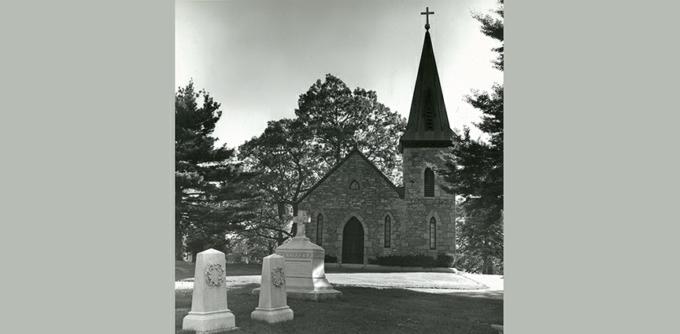
Culture
''It might be truly said that all living Rome went to the great graveyard to honor its dead... A vast crowd passed in and out of the gates... there were very few indeed whose hands were not laden with a tribute of affection for their dead," reported The Pilot in November 1879. Carrying "crowns of flowers, and of laurel, wreathes of immortelles, devices in black and white beads, with the name of the beloved lost one," the devoted mourners decorated the graves of the departed throughout the cemetery.
All Souls' Day, celebrated on Nov. 2, is a day of devotion within the Church. The feast day "calls us once a year to a remembrance of those who have gone before with the sign of faith upon them." The theological basis of the feast day reminds the living that the souls of the departed can be cleansed through the prayers and celebration of Mass on this holy day. As explained in The Sacred Heart Review in 1915, "on this day every Catholic should attend Mass... to show his desire to befriend the poor souls suffering in purgatory." Although the feast day is not one of obligation, the newspaper explained at the time, "There are few holy days in the year of more deep and tender import, there are few whose significance comes home so surely to the pious Catholic heart."
It is because of this significance that the celebration of All Souls' Day drew massive crowds to cemeteries across the globe in early November to pray for the souls of those who had departed. For example, The Pilot reported in 1866 that in Paris alone, 900,000 people flocked to cemeteries to honor the holy day of devotion. From Paris to Rome to Boston and beyond, All Souls' Day serves as a reminder of the living's commitment to the souls of the deceased.
Local celebrations of All Souls' Day in the Archdiocese of Boston were also very common and often elicited powerful scenes of devotion and faith. Special trains were often arranged to accommodate the large crowds of mourners gathering in the cemeteries, and in some cases, Mass was held outside. In 1869, The Pilot explained that to accommodate "a throng by far too large to enable them to be present at the Holy Sacrifice in the Chapel," Mass was "offered at the entrance of the Mortuary Chapel" to make sure that all in attendance could take part.
A particularly significant location for the celebration of All Souls' Day within the Archdiocese of Boston is Holyhood Cemetery, located in Brookline. Designated trains would depart at 8 a.m. from Boston and Albany Depot, and returning trains would leave at 11:45 a.m. at the cemetery, aiming to give people easy transport on the significant day.
In 1861, the crowd of devoted mourners gathered at Holyhood were treated to a particularly significant site as they gathered to pray for their departed loved ones. On that day, "the old Cathedral bell has sent forth its silver tones again to summon the Faithful to their worship." The bell, originally raised in 1802 by Father Francis Anthony Matignon and Bishop Jean-Louis Lefebvre Cheverus, had hung in the cathedral on Franklin Street, where the "silver tones" served as a familiar tune to the local Catholics. Having been removed from the cathedral in October 1860, the impressive bell sat silent for an entire year prior to being brought to Holyhood. Perched in the "lofty and graceful spire" that peered above the cemetery and "the glittering cross... which the pure hearted Cheverus placed upon the old church, in Franklin Street," the bell tower in Holyhood became visible "from the height of Chestnut (sic.) Hill, and from the plains of Needham."
As the crowd gathered with flowers to decorate the graves of their loved ones in 1861, the former Cathedral bell rang for the first time in a year where "a large and pious congregation answered its call." Due to its significance at the cathedral on Franklin Street, the song of the bell brought forth "recollections of the happiest moments of man's life" on that holy day. The Pilot reported that "A lady remarked to us, on hearing the first toll, 'it reminds me of my first communion!'"
The hallowed ground of the cemetery served as the perfect location for the bell. Upon its arrival to the cemetery, it hung in the spire of the Holyhood Chapel, designed by Patrick C. Keeley, the noted architect who designed the Cathedral of the Holy Cross in Boston. The return of the bell to service and to Holyhood created "a monument of early Catholicity in New England," where "for many long years of undisturbed work it will awaken the soul of the Christian to his duty of praying for the repose of departed souls." Although removed from the belfry in 1988, the bell remains at Holyhood Cemetery, where it can still be witnessed by those who gather to pray for the souls of the departed on All Souls' Day, all these years later.
JOY ZANGHI IS AN ARCHIVIST FOR THE ARCHDIOCESE OF BOSTON.
Recent articles in the Culture & Events section
-
Scripture Reflection for Oct. 27, 2024, Thirtieth Sunday in Ordinary TimeDeacon Greg Kandra
-
A home for Lithuanian Catholics in BostonThomas Lester
-
What all Souls' Day is all about?Russell Shaw
-
Lessons from my Catholic school journeyEileen McLaughlin
-
'God wants us to be friends'Ron Fish and Lewis Sassoon


















